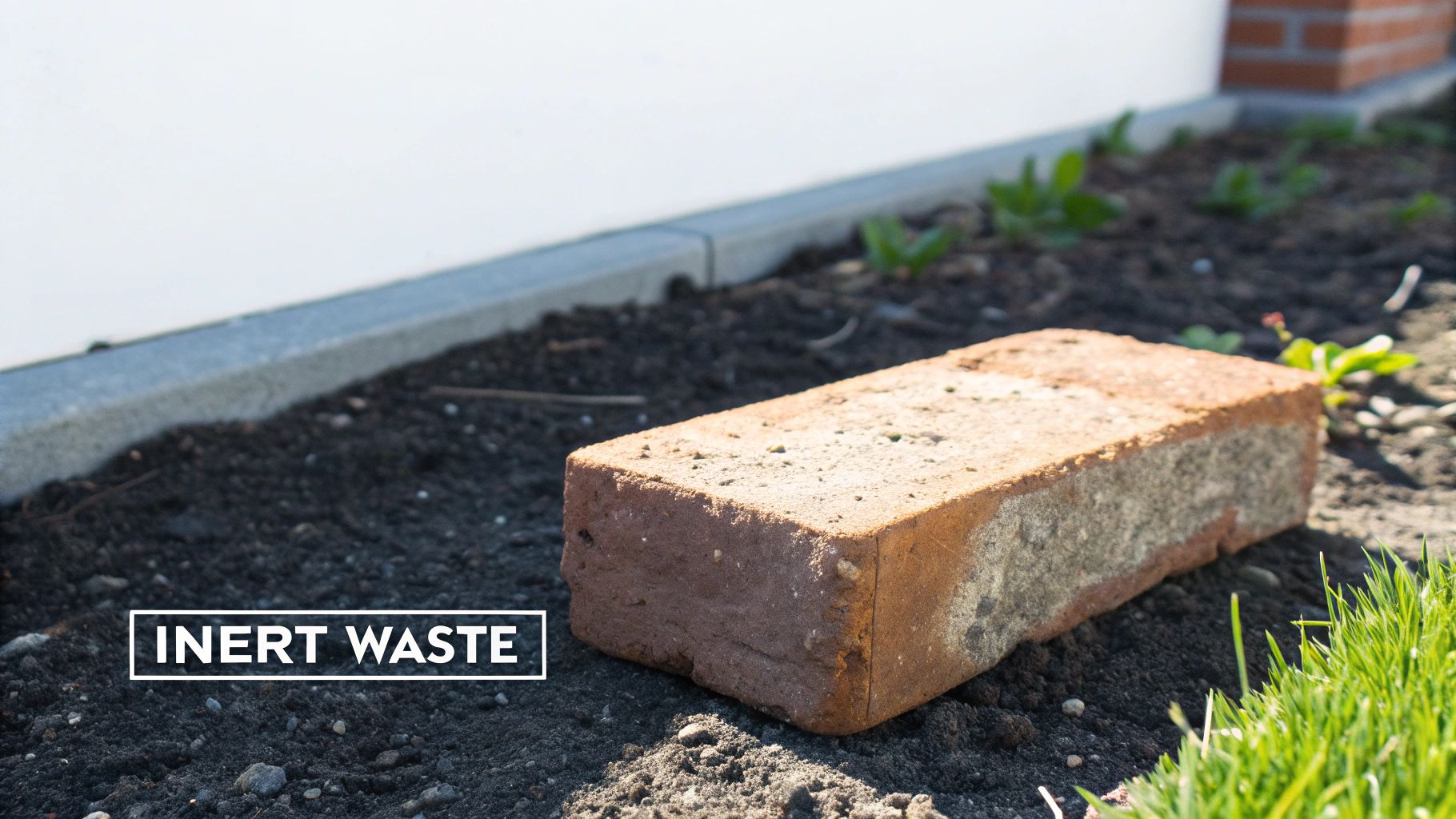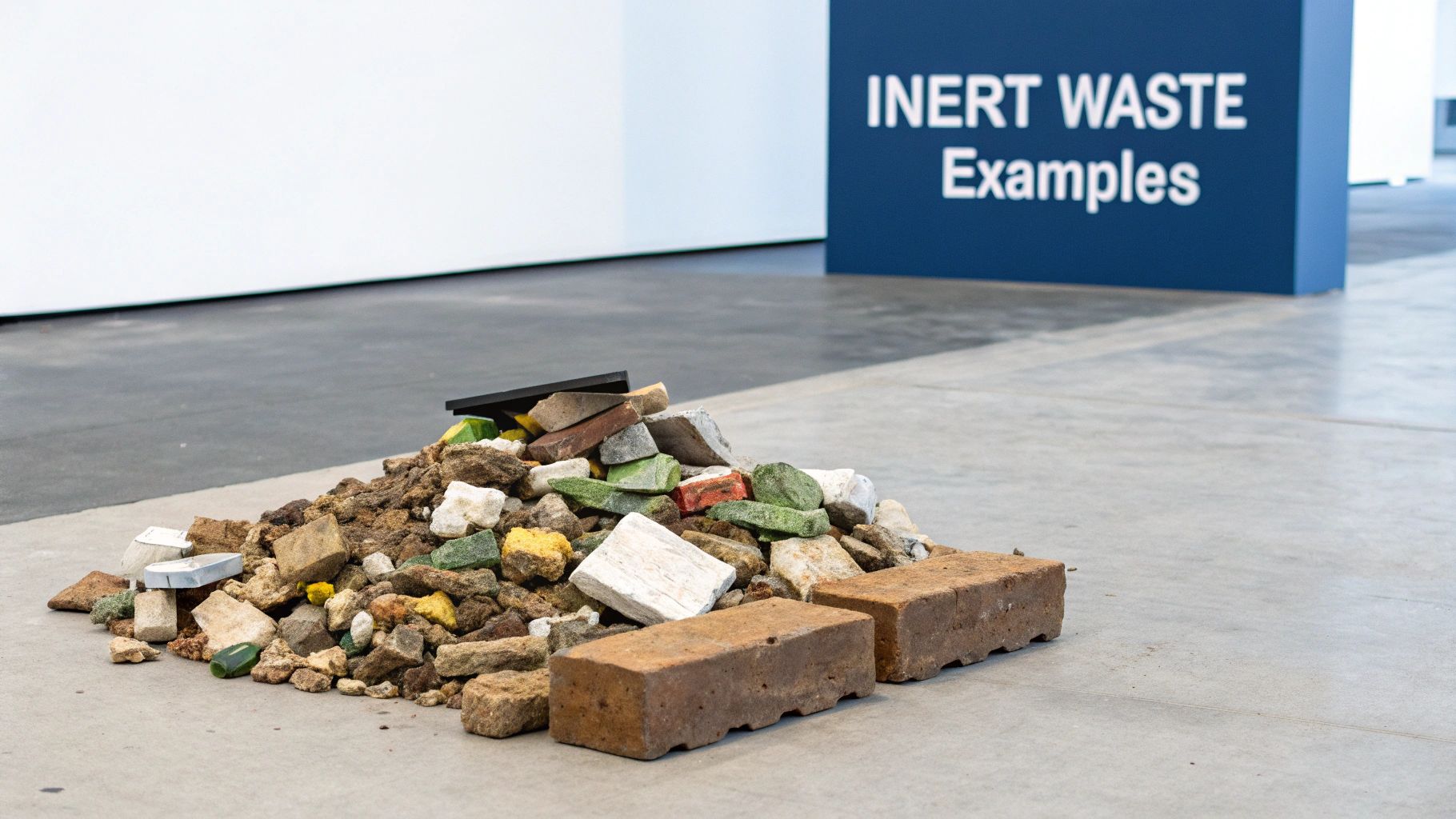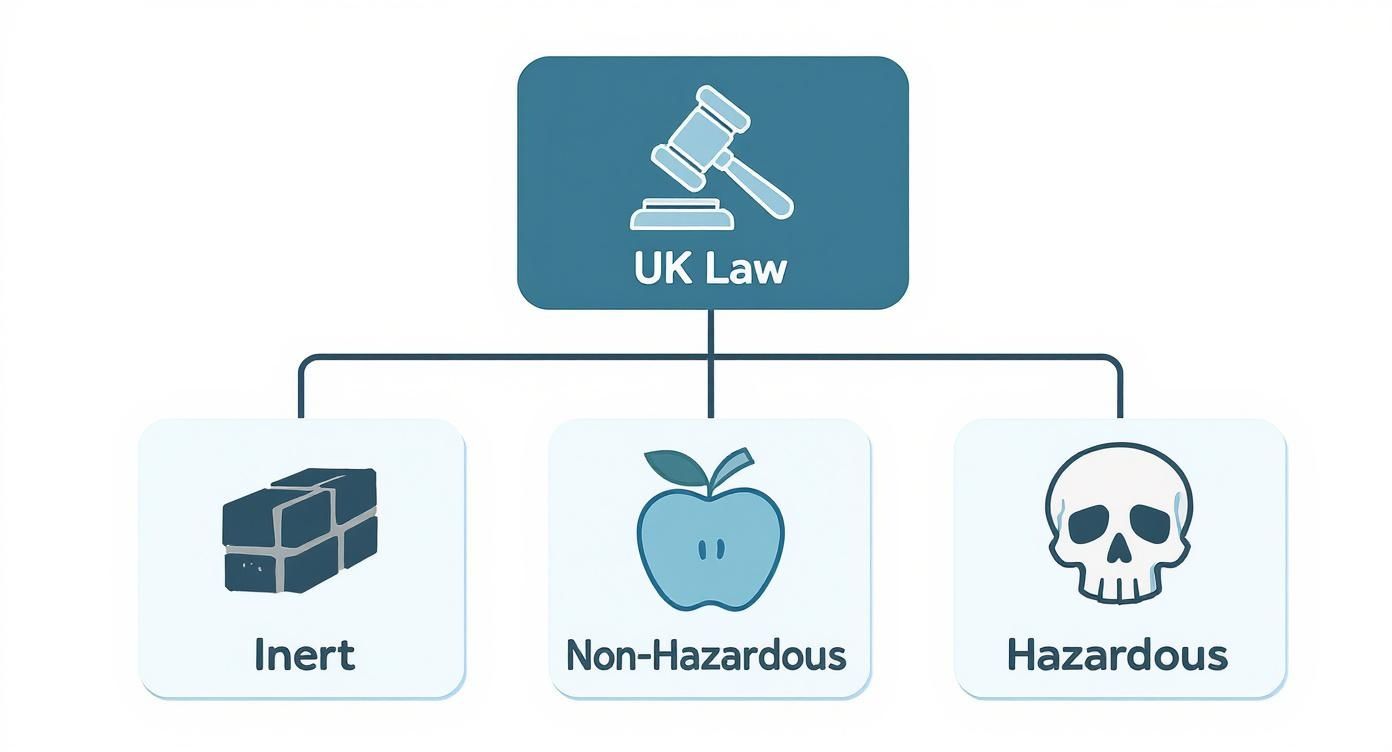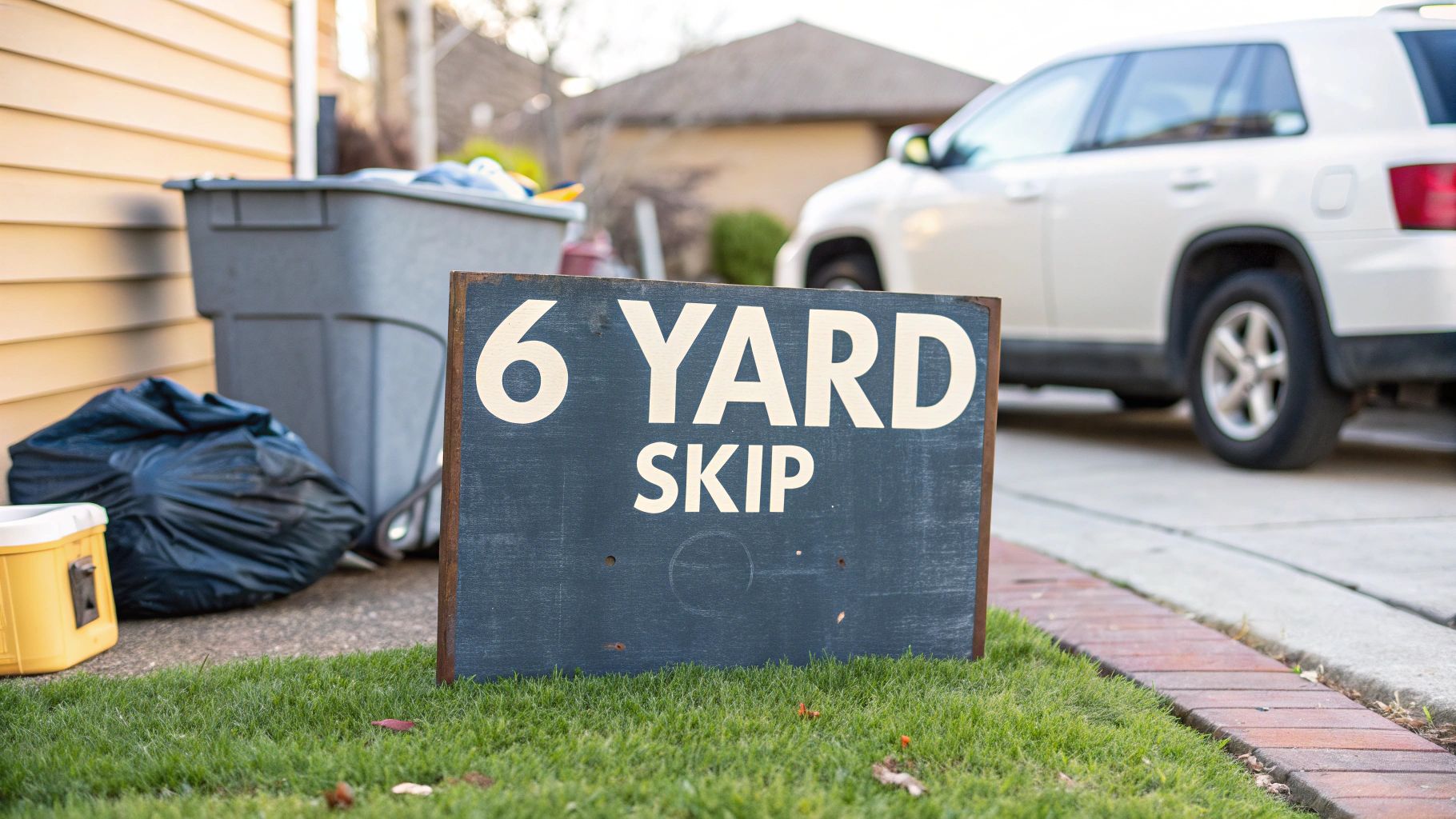What Is Inert Waste Your Complete UK Guide
What Is Inert Waste Your Complete UK Guide
When you hear the term ‘inert waste’, what comes to mind? For most people, it’s the stuff you see on a building site: piles of rubble, soil, bricks, and chunks of concrete. And they'd be right.
At its core, inert waste is simply any material that won’t chemically or biologically react with its surroundings. Think of it as the steady, unchanging stuff. It doesn’t decompose like food scraps, rot like wood, or release nasty chemicals when it gets wet. It just… sits there.
Understanding What Inert Waste Really Is

The key word here is stability. These materials are the quiet, predictable characters in the world of waste management. An old brick will fundamentally stay a brick. A piece of concrete remains concrete. They don't burn, give off gases, or create a toxic soup (known as leachate) in a landfill.
This inherent stability is what makes inert waste a completely different beast compared to general or hazardous waste. It’s far safer and much simpler to handle, recycle, or dispose of.
The Defining Characteristics
For waste to be officially classed as 'inert', it’s not enough for it to just look solid. It has to meet strict criteria to prove it’s non-reactive. The main properties are:
- It undergoes no significant physical, chemical, or biological changes. It stays the same over a very, very long time.
- It won’t burn or combust under normal circumstances.
- It doesn't contain pollutants that could harm people or the wider environment.
To make this crystal clear, here’s a quick rundown of what makes inert waste, well, inert.
Key Characteristics of Inert Waste at a Glance
| Characteristic | Simple Explanation | Why It Matters |
|---|---|---|
| Non-Reactive | It won't react with other materials, air, or water. | This means it's safe to store and won't create dangerous chemical reactions in a landfill or recycling facility. |
| Non-Decomposable | It doesn't rot or break down biologically over time. | Unlike organic waste, it won't produce methane (a potent greenhouse gas) as it sits in a landfill. |
| No Leaching | It won't release harmful substances when exposed to water. | This protects groundwater and soil from contamination, which is a major risk with other waste types. |
| Non-Combustible | It doesn't catch fire. | This reduces fire risk at waste management sites, making it much safer to handle in bulk. |
Essentially, these properties confirm that inert materials pose a very low risk to the environment, which is why they are managed under a different set of rules.
At its heart, inert waste is defined by what it doesn't do. It doesn't decompose, it doesn't react, and it doesn't contaminate its surroundings.
This classification is a huge deal for waste management in the UK, especially for the construction, demolition, and excavation sectors which produce tonnes of it. In 2023, the UK generated around 67.8 million tonnes of construction and demolition waste, and a massive chunk of that was inert.
The good news? The recovery rate for these materials is hovering around an impressive 90%. This means millions of tonnes of old bricks, concrete, and soil are being crushed, screened, and recycled back into new building projects instead of just being dumped in a hole in the ground. You can explore more UK waste statistics and see for yourself how properly managing this waste stream is helping to build a more circular economy.
Common Inert Waste Examples in Your Project

Knowing the theory is one thing, but spotting inert waste in the middle of a dusty, chaotic building site is what really counts. These materials are the bread and butter of most construction, demolition, and landscaping jobs. Once you know what you’re looking for, you’ll see them everywhere.
Picture this: you’re breaking up an old, cracked patio. Those chunks of concrete, the broken paving slabs, and the hardcore sub-base you dig up are all classic inert waste. It's the same story when digging foundations for an extension – all that uncontaminated soil, clay, sand, and stone you pull out is inert.
Because these materials are so stable and predictable, they are perfect candidates for recycling.
Everyday Inert Materials
Here’s a practical rundown of the most common inert waste you’re likely to come across. Keeping this stuff separate from your other rubbish is the secret to keeping your disposal costs down and staying on the right side of the law.
- Bricks and Blocks: Any clean bricks or concrete blocks from a dismantled wall, even with a bit of mortar still attached.
- Concrete and Rubble: The leftovers from old driveways, paths, or building foundations. For a deeper dive, our guide on how to dispose of concrete has more detailed advice on tackling this heavy material.
- Ceramics: Think old bathroom or kitchen tiles. This also includes broken toilets and sinks, as long as you've removed all the non-ceramic bits like taps and pipes.
- Uncontaminated Soil and Clay: Often called ‘muck away’, this is simply the earth you dig out during landscaping or foundation work.
- Stone and Slate: Natural materials like old rockery stones or roofing slates fit squarely into this category.
Segregating these items properly means they can be crushed down and given a new life as construction aggregate – a vital ingredient for building roads and new foundations.
The Impostors: What Is Not Inert Waste
It’s just as important to know what isn't inert as what is. Tossing non-inert materials into an inert waste skip is a costly mistake. It can get your entire load re-classified and leave you facing a much higher bill. These materials might look harmless, but they have properties that make them hazardous or reactive.
Be warned: a single piece of the wrong material can contaminate an entire skip load. Vigilance is your best defence against unexpected disposal fees.
Here are the top offenders to keep separate at all costs:
- Plasterboard: It contains gypsum, which can produce toxic hydrogen sulphide gas if it gets wet in landfill. Plasterboard must always be kept separate.
- Treated Wood: Fence panels, decking, and old railway sleepers have usually been treated with chemicals, which means they can't be classed as inert.
- Asphalt and Tarmac: These contain hydrocarbons and are not considered inert.
- Glass and Metal: While they are recyclable, they aren’t inert and have to go through completely different waste streams.
- Green Waste: Garden clippings, turf, and tree roots are biodegradable – they rot down. This means they can’t be mixed with inert waste.
Why UK Waste Regulations Matter for Your Project
Getting your head around the rules for inert waste isn’t just about ticking boxes. It’s about saving yourself money, doing right by the environment, and most importantly, keeping your project on the right side of the law. The UK's waste regulations are there for a reason – to make sure materials are handled safely and properly, which saves everyone a lot of headaches down the line.
The cornerstone of these rules is the Landfill Directive. This is what officially splits waste into three main camps: inert, non-hazardous, and hazardous. This isn't just bureaucratic waffle; it directly affects where your waste can go and, critically, how much you'll pay to get rid of it. Inert waste is the cheapest to dispose of simply because it poses the lowest risk to the environment.
Your Legal Responsibility: The Duty of Care
Whether you’re a homeowner clearing out the garden or a contractor managing a massive building site, the law sees you as the waste producer. This means you have a legal Duty of Care to make sure that waste is managed correctly, from the second it’s created to its final resting place.
You can't pass the buck on this one. It means you have to take all reasonable steps to:
- Stop anyone from dumping, treating, or disposing of your waste illegally or harmfully.
- Prevent anyone else from breaking the rules of their environmental permit.
- Check that the person or company you hand your waste over to is actually authorised to take it.
- Provide a perfectly accurate description of the waste when it changes hands.
For every single load of waste that leaves your site, you must ensure it has the correct paperwork. You can dive deeper into this crucial legal document in our guide explaining what a waste transfer note is and why it's so vital for keeping your project compliant.
The Gatekeeper for Inert Landfills: The WAC Test
So, how does a landfill site know for sure that your waste is genuinely inert? For bigger commercial jobs, particularly those digging up lots of soil, they'll often ask for a Waste Acceptance Criteria (WAC) test. Think of it as a chemical MOT for your waste.
A sample of your soil or rubble is sent off to a lab and put under the microscope. They’ll analyse it for contaminants like heavy metals, oils, and other nasties to confirm nothing harmful will leach into the ground over time.
A WAC test is the scientific proof you need to show your waste is clean enough for an inert landfill. Passing this test is your golden ticket to the lowest disposal rates.
Now, for smaller domestic jobs, a WAC test is almost never needed. As long as you can confidently say your soil, bricks, or rubble come from a clean, uncontaminated source and you've kept it separate from other rubbish, you can take advantage of the lower costs for inert waste. Getting this right from the start is a win for both your wallet and the planet.
Smart and Sustainable Disposal Options
So, you've got a handle on what inert waste is and how the law sees it. That's the first step. Now for the practical part: how to manage it in a way that’s smart, saves you money, and is genuinely better for the environment. Getting this right isn't just about ticking compliance boxes; it's a chance to slash your disposal costs and be part of a greener construction industry.
The best way to think about your inert waste is not as rubbish, but as a resource. Old bricks, broken concrete, and rubble have real value. Instead of being lost to landfill forever, these materials can be crushed, screened, and reborn as high-quality recycled aggregate.
This isn't just a feel-good exercise. That recycled aggregate gets a second life building new roads, creating solid foundations for new builds, or forming the sub-base for a new patio. Every tonne reused is a tonne that doesn't have to be quarried from a hillside, which saves energy, protects natural landscapes, and lowers the carbon footprint of the next project down the line.
The diagram below shows exactly how UK law separates waste into different streams. This official classification is what makes the whole system work.

It’s this clear legal distinction that opens up the cost-effective and sustainable disposal routes for inert materials.
Choosing The Right Disposal Route
When you’re left with a pile of clean inert material, you have several great options that completely bypass the expensive and wasteful landfill route. By picking one of these, you’re actively doing your bit for a more circular construction economy.
Your main choices are:
- Dedicated Recycling Facilities: These are specialist sites kitted out with powerful crushers and screeners. They’re designed to do one thing brilliantly: turn your waste into certified recycled aggregate, ready for its next job.
- Aggregate Suppliers: Many local firms that sell new aggregates will also take in clean inert waste. They often process it themselves or have a recycling partner, making it a really convenient drop-off point.
- On-site Reuse: If you’re on a larger project, think about crushing the waste right where you are. You can create the very sub-base you need for the next phase of the build, saving a fortune on both disposal and buying new materials. You can learn more about the benefits in our guide to the recycling of aggregates.
The Financial Incentive Is Powerful
If you need one single compelling reason to keep your inert waste separate, it’s the cost. Landfill Tax is a hefty government levy designed to make people think twice about burying waste, and the rates are worlds apart depending on what you’re throwing away.
The standard rate of Landfill Tax for mixed, active waste is currently £103.70 per tonne. In stark contrast, the lower rate for qualifying inert waste is just £3.30 per tonne.
That huge difference isn't a typo. It’s a direct financial reward for good waste management. By making sure your bricks, soil, and rubble don't get mixed with general rubbish like wood, plastic, or plasterboard, you can cut your disposal bill by over 95%. It's one of the simplest and most effective ways to control costs on any construction or renovation job.
A Practical Guide to Hiring an Inert Waste Skip

Hiring a skip is often the most sensible way to get rid of the heavy, bulky stuff from a building or landscaping job. But here’s a tip that can save you a serious amount of money: when you call your skip company, specifically ask for an ‘inert waste only’ skip.
Why the discount? Because clean, separated inert material isn't just rubbish—it's a resource. Skip companies find it much cheaper to process a pure load of soil and rubble than a mixed one, which needs careful sorting and faces hefty landfill taxes. They pass that saving on to you, but there’s one non-negotiable condition: zero contamination.
The Golden Rule: Avoid Contamination at All Costs
The biggest mistake you can make with an inert skip is letting something else sneak in. Just one wrong item can turn your cheap disposal option into a very expensive headache. The whole load gets reclassified as mixed general waste, and you can easily see the price double or even triple.
It’s just like your recycling at home. If you chuck a greasy pizza box into the paper bin, you risk the entire batch being rejected. The principle is the same here, but the financial stakes are much, much higher.
To keep your skip compliant and your wallet happy, you have to be obsessive about keeping these items out:
- Plasterboard: This is the absolute number one offender. Its gypsum content creates toxic gas when it breaks down in landfill conditions.
- Wood, Metal, and Plastic: While you can recycle these, they have their own waste streams and can't be mixed with inert materials.
- Green Waste: Things like garden clippings, turf, and soil still attached to roots are biodegradable and must be kept separate.
- General Rubbish: Think food wrappers, old tools, paint tins, or any other site waste. They are strictly forbidden.
The second a non-inert item lands in that skip, you've lost the financial and environmental perks of keeping it clean. Your best bet is to set up a separate bin or a designated spot for everything else to avoid any costly mix-ups.
Choosing the Right Skip and Staying Compliant
Once you're committed to keeping your inert waste pure, the rest is pretty straightforward. You just need to pick the right size skip and make sure you’re following the rules, especially if it has to live on a public road for a while.
1. Estimating Your Skip Size
Inert stuff like soil, bricks, and concrete is incredibly heavy. Because of this, skip companies won’t let you hire their biggest containers (usually anything over an 8-yard skip) for purely inert loads. The lorry simply wouldn't be able to lift it legally and safely once it's full. For most home projects, like digging foundations or ripping out an old patio, a 4-yard or 6-yard skip is almost always the right choice.
2. Placing a Skip on a Public Road
If you don't have a private driveway or garden to place the skip on, you'll need a permit from your local council to put it on the road. Your skip hire company will sort this out for you, but it does add to the cost and can take a few days to get approved, so make sure you plan ahead. The skip will also need to have safety lights and cones fitted.
Following these simple bits of advice will help your project run smoothly, safely, and without any nasty, unexpected bills.
Your Inert Waste Questions Answered
Even when you've got a decent handle on what inert waste is, you'll inevitably hit a few grey areas on a project. Getting it wrong can be costly, so let's clear up some of the most common questions that pop up.
Is Soil Always Considered Inert Waste?
No, and this is a big one. You can't just assume all soil is inert. While clean, natural soil dug straight out of the ground (what we often call 'muck away') usually fits the bill, its history is everything.
The real question is: where did it come from?
Soil from an old industrial site, a garage forecourt soaked in oil spills, or a garden infested with something like Japanese Knotweed is absolutely not inert. This kind of soil is contaminated. In some cases, it’s even classed as hazardous waste, which needs specialist (and much more expensive) disposal.
For big commercial jobs, a Waste Acceptance Criteria (WAC) test is the official way to prove your soil is clean. On a smaller domestic project, if you're 100% sure the soil is just from a normal garden area with no dodgy history, you're generally safe to treat it as inert.
Why Can I Not Put Plasterboard in an Inert Waste Skip?
Plasterboard is the number one offender when it comes to contaminating inert skips. It might look harmless, like simple chalky rubble, but there’s a crucial scientific reason it's strictly banned.
The problem lies with what's inside: gypsum.
When gypsum gets wet and is buried with other organic waste in a landfill, it starts a chemical reaction. This reaction produces hydrogen sulphide – a toxic, flammable, and incredibly foul-smelling gas. It's a genuine hazard to people's health and the local environment.
Because of this chemical instability, you must always keep plasterboard separate. If you mix it in with your inert waste, the entire load will either be rejected at the gate or you'll be re-billed at a much higher general waste rate.
What Happens if I Accidentally Contaminate My Inert Skip?
Mistakes happen, but contaminating an inert skip has a direct financial sting. When your skip gets back to the licensed waste transfer station, the first thing they do is inspect it.
If they find non-inert items mixed in, they have to re-classify the whole load. It can no longer be processed as cheap, easily recyclable inert material. Instead, it becomes 'mixed general waste', which is far more expensive to sort and sends landfill tax costs soaring.
That extra cost doesn't just disappear. The skip hire company will pass it straight on to you. A surcharge for a contaminated skip can easily double or even triple the original price you were quoted. What looked like a cheap and easy option suddenly becomes a very expensive mistake. The easiest way to avoid this is to have a separate bag or bin on site for any other rubbish.
Do I Need a Special Licence to Transport Inert Waste?
This all comes down to who you are. The rules for businesses and homeowners are completely different.
- For Businesses: Yes. If you're a business of any kind – a limited company, a sole trader, a builder, or a landscaper – you must have an upper-tier Waste Carrier Licence from the Environment Agency. This is a legal requirement to transport any waste that's produced as part of your commercial work, even if it's just from your own job site.
- For Homeowners: No. If you're a homeowner moving waste from your own house (like from a DIY project) in your own vehicle, you don't need a licence. However, you still have a legal 'Duty of Care'. This means you are responsible for making sure the waste goes to a properly licensed facility that’s permitted to take it. You can't just dump it anywhere.
For both contractors and homeowners, using a reputable and fully licensed waste management company is the simplest and safest path. It ensures all your legal boxes are ticked, and you can get on with your project without any worries.
Managing waste correctly is key to a successful project. For straightforward, compliant skip hire and expert advice on handling inert and other waste streams, contact The Waste Group. We make the process simple, affordable, and environmentally responsible. Find out more at https://www.thewastegroup.co.uk.


